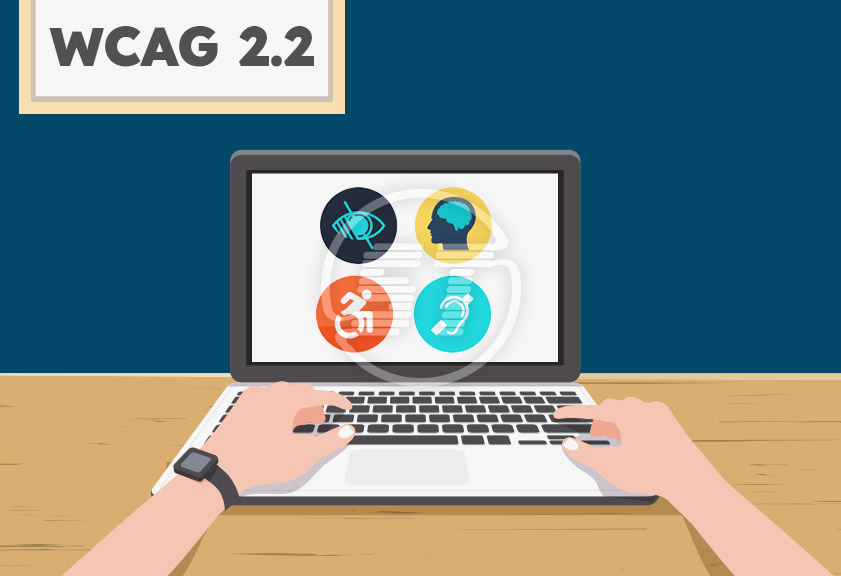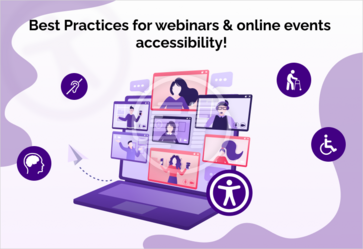The World Wide Web Consortium(W3C) is the supreme authority for laying out the accessibility goals through web design and build. These are to be universal and followed worldwide by all business enterprises. It has laid out Web Content Accessibility Guidelines (WCAG) that rule how to make your web content accessible to all including people with disabilities or different needs. Accessibility entails a wide range of disabilities that include visual, auditory, speech, cognitive, physical, and neurological disabilities. WCAG guidelines have been the cardinal principles for businesses to make them universally accessible.
The W3C has been updating the accessibility guidelines and finalized the most recent version i.e. WCAG (2.2)
Here are some of the quick facts about the latest WCAG2.2 version.
1. WCAG 2.2 is a working draft, not a final version
The expected date of the WCAG 2.2 accessibility publication is anticipated to be in June 2021 and the final date has been pushed from its earlier stipulated timelines. So it is still in its draft state. The first draft was likely to be released at the CSUN Assistive Technology Conference. If you have any feedback, you can submit it to the Accessibility Guidelines Working Group via GitHub or the W3C mailing list.
2. WCAG 2.2 is expected to become a recommendation around June 2021
Earlier it was supposed to be around November 2020. But pushed to June 2021. It is going to be an official recommendation soon. It would become a legal requirement after the publication.
3. WCAG 2.2 is rooted in WCAG 2.1
Just like how WCAG 2.1 guidelines were built on 2.0, in the same way, WCAG 2.2 is built on WCAG 2.1. These updates that extend WCAG 2.x series of guidelines are backward compatible and they keep up with the conformance model. This means the current criteria include the addition of the new guidelines to the already existing guidelines. Most enterprises aim for level A and AA conformance. Any changes that are rolled out will not impact them in a major way and hence most organizations can lay back and relax and they are likely to meet the conformance standards. So, if your organization meets WCAG 2.1 guidelines, chances are that you will not be impacted much by the new guidelines. This, however, is not applicable to the earlier version guidelines such as 2.0.
4. Likely to have 9 success criteria
The current draft shows 9 new success criteria.
- 4 at Level A with Focus Visible Enhanced
- 4 at Level AA
- 1 at Level AAA
These criteria aim at assisting users having low vision, cognitive & learning disabilities, motor disabilities. This benefits the users who have disabilities on mobile devices.
Let us look into the current editor’s draft WCAG 2.2 criteria
Level A
- Accessible Authentication
- Findable Help
- Fixed Reference Points
- Redundant Entry
Level AA
- Dragging Movements
- Focus Appearance (Minimum)
- Visible Controls
- Pointer Target Spacing
Level AAA
Some criteria may be moved between levels. For instance, one current criterion may move from Level AA to Level A. Since most enterprises require to conform to Level A and AA, any change in this will have zero or negligible impact on business requirements.
Listed below are some success criteria:
- Focus Appearance (Minimum and Advanced) - This is for the benefit of sighted users who navigate the web pages with the keyboard have a clearly visible focus indicator for the page pointers. Here the focus indicators and minimum contrast are denied. For level AA it should be in the contrast ratio of 3.1 and for level AAA, it should be 4.5 to 1.
- Fixed Reference Points - This is for EPUB and other publication formats. Things like page numbers, page locators should be accessible and adjustable when the page is displayed.
- Dragging - Drag-and-drop actions should be precise and this is important for people with motor disabilities.
- Pointer Target Size - You need to activate small buttons on touch screens which is usually challenging for people with motor disabilities. Have a minimum distance between two interactive elements to help people avoid any unnecessary activation of wrong elements.
- Finding Help - This makes it easier for the users who need help finding information like contact information or FAQs, etc.
- Hidden Controls - Some elements like buttons are hidden to reduce the visual clutter on the webpage. Visitors may struggle to complete the task if there is any difficulty.
- Accessible Authentication - People tend to be forgetful of their authentication details. So there must be cognitive tests for remembering details.
- Redundant Entry - Some forms require inputs to be entered more than once. So one needs to avoid the mechanical entries and there should be less strain filling forms.
5. WCAG 2.3 unlikely to be there
As we go forward, there won’t be a WCAG 2.3. Efforts are being directed towards a future accessibility guideline i.e. WCAG 3.0, which will be a major succession version of the WCAG guidelines. They won’t be backward compatible. No official name is set yet but contemplation is that a first public working draft would be out anytime soon. The final version is anticipated to be published around November 2023.
6. Supporting Documents are in progress
There is a core working group that has been relentlessly working on building techniques that will suffice to go into the document. Any failure instances in the WCAG 2 series guidelines will lay special emphasis on creating techniques for the new criteria in WCAG 2.2. The additional supporting documents on how to meet WCAG 2.2 are in progress and these would be helpful for understanding WCAG 2.2.
7. WCAG 2.2 adoption into the existing regulations is still unknown
- There is no information about the adoption of the details into Section 508 by the US Government
- Not until the 2nd half of the year 2021, these WCAG 2.2 guidelines will be referenced by the accessibility advocates in the litigation and settlement agreements.
- Some US states, higher educational institutions, enterprises, and organizations adopted WCAG 2.1 while others are still on 2.0. Some are likely to adopt these latest standards while a few others may hold back.
- The W3C standards body that has created EU standard EN 301 549 will also foresee WCAG 2.2 criteria for the inclusion of it in the EU standard. Of course, this may take several months and there are no confirmed details as yet.
- We do expect the Department of Justice (DoJ) to take a more proactive stance on digital web accessibility.
Any business enterprise or for that matter anyone who wants an inclusive webspace would consider their way of doing business and their digital sources to be ADA web compliant. If you strive to be one, you would want to track these updates as they are important in the design of the digital content. You are also free to contribute any feedback or comments to the W3C.
The existing draft of WCAG 2.2 standards are in the AMP platform and these are not finalized yet. They are still in the draft nature. Once these standards are locked down, AMP will be updated with the latest WCAG version. Before that happens, it is required to actively consider each criterion, evaluate it automatically and manually, and all address a testing approach in the platform for every new criterion.
Skynet Technologies is offering ADA compliant website design and development services followed by Web Content Accessibility Guidelines (WCAG) standards. We can make your Drupal, WordPress, Magento, PHP, Laravel website or Android, iOS Mobile App ADA Compliant to make it accessible for everyone.


